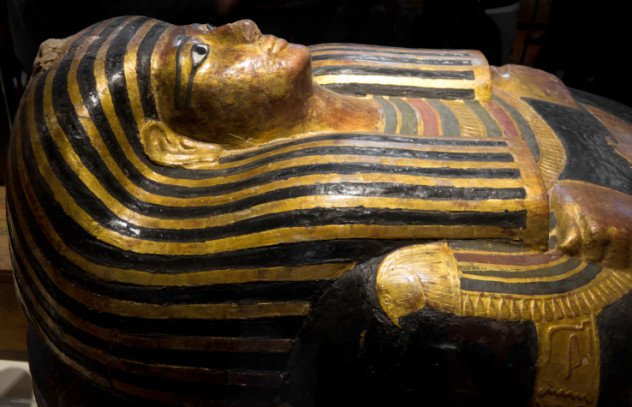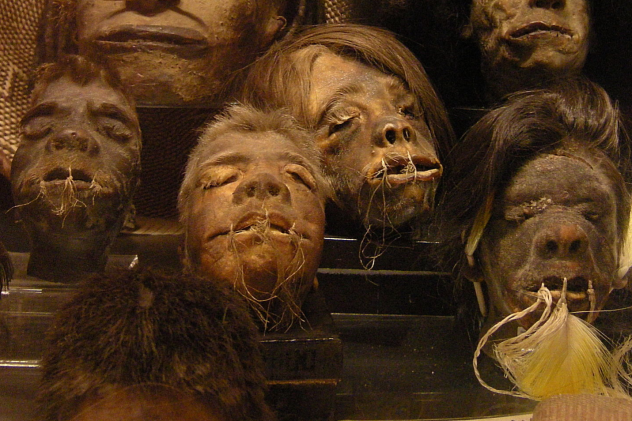 Technology
Technology  Technology
Technology  Misconceptions
Misconceptions 10 Hilarious (and Totally Wrong) Misconceptions About Childbirth
 Weird Stuff
Weird Stuff 10 Warning Labels That Exist Because Someone Actually Tried It
 Health
Health Ten Confounding New Inventions from the World of Biomedicine
 Creepy
Creepy 10 Death Superstitions That Will Give You the Creeps
 Movies and TV
Movies and TV 10 Movies That Get Elite Jobs Right, According to Experts
 Weird Stuff
Weird Stuff 10 Times Real Laws Were Based on Bizarre Hypotheticals
 Animals
Animals 10 Inspiring Tales of Horses Being Human
 Mysteries
Mysteries Top 10 Haunting Facts About the Ghost Ship MV Alta
 History
History 10 Surprising Stories About the Texas Rangers
 Technology
Technology 10 Awesome Upgrades to Common Household Items
 Misconceptions
Misconceptions 10 Hilarious (and Totally Wrong) Misconceptions About Childbirth
 Weird Stuff
Weird Stuff 10 Warning Labels That Exist Because Someone Actually Tried It
Who's Behind Listverse?

Jamie Frater
Head Editor
Jamie founded Listverse due to an insatiable desire to share fascinating, obscure, and bizarre facts. He has been a guest speaker on numerous national radio and television stations and is a five time published author.
More About Us Health
Health Ten Confounding New Inventions from the World of Biomedicine
 Creepy
Creepy 10 Death Superstitions That Will Give You the Creeps
 Movies and TV
Movies and TV 10 Movies That Get Elite Jobs Right, According to Experts
 Weird Stuff
Weird Stuff 10 Times Real Laws Were Based on Bizarre Hypotheticals
 Animals
Animals 10 Inspiring Tales of Horses Being Human
 Mysteries
Mysteries Top 10 Haunting Facts About the Ghost Ship MV Alta
 History
History 10 Surprising Stories About the Texas Rangers
10 Horrible Myths And Misconceptions About Embalming
Picture a natural death—Hollywood style. The eyes close softly and the person looks as though he or she is in a peaceful sleep. In reality, the deceased look like I do when I sleep, mouth gaping and face squished against the pillow. It’s the embalmer’s job to transform that image into that of Sleeping Beauty. Since the embalming process is not done in front of a live audience, a lot of rumors and myths surround this procedure. As an embalmer with 15 years of experience, I’m here to help clear up some of the confusion.
10 Embalmers Remove All Your Organs

What did they do with Grandpa’s heart? Where is Aunt Jane’s brain?
Say the word “embalming” and most people think of the Egyptians, craftily removing the brain through the nose and storing pickled organs in canopic jars. Embalming has come a long way, baby. The Egyptians only had one goal in mind: preservation. Today, preservation is one of many goals. Preservation has to be balanced with restoration. So, while removing organs may help you become nice and leathery, today’s embalming is less severe.
If embalming were a surgery, it would be considered minimally invasive. All the embalmer needs is access to an artery, and that only requires an inch-long incision. The misconception might come from confusion between embalming and autopsy, in which organs are removed, weighed, studied, and sometimes sampled for testing. This is done by a pathologist, not an embalmer. After an autopsy, organs are placed back into the body prior to receipt at the funeral home for embalming. However, this does alter the approach to embalming since the minimally invasive opportunity has passed.
9 Dead Guys Can Sit Straight Up

We all have that relative, you know, the grandfather that was in a morgue once, probably during a war, and saw a corpse sit straight up! He’ll swear on his life that he saw it happen.
So, let’s try an experiment. Lie flat on the floor. Now, using only stomach muscle, sit straight up—fast! How’d that work for you? Think of the number of muscles that have to work perfectly in conjunction for that to happen. Now, try it dead. If, by some miracle, movement could occur in a muscle after death, then it would really be a miracle for them to all work together.
“What about rigor mortis?” you ask. Muscles require energy to relax. (I’m not gonna explain that here, but here’s a physiology book that does.) After death, the energy needed to relax those muscles is exhausted and not renewed, therefore the muscle stays locked in its current position. Even more energy would be required to move or flex a muscle, and remember, you’re all out of energy. Therefore, you may get stiff after death, but you won’t be moving.
I should mention that the moment of death is not as clear-cut as you might imagine, and the correlation between heart and brain death can get a little fuzzy. Nanoseconds after death, the brain may be releasing its last few signals that would result in a twitch or two.
8 Embalmers Sew Your Lips Shut

It must be true—we’ve all seen the movie where the zombie pops out of the ground and can’t speak until he takes a knife to the strings pursing his lips. You may feel totally relaxed even with your mouth shut, but muscles are keeping your jaw closed. When they relax, your mouth will fall open. Since we don’t want anyone catching flies, we need to get that flapper shut.
There are a few ways to do this. A common way is to use small, sharp needles that can be anchored into the bone of the upper and lower jaw, one on each side. They are attached to wires that can be twisty-tied shut. This may sound unpleasant, but I guarantee it’s better than your last visit to the dentist.
If poor bone structure makes this difficult, a needle and suture may be used, but it doesn’t have much to do with your lips, but rather the muscle that attaches your lips to your gums. Same idea—upper, lower, and tie a knot.
7 Like Vampires, Embalmers Suck Your Blood Out

While it’s true that blood needs to be removed to slow decomposition, it’s not sucked out. It’s pushed out. Since your circulatory system is . . . well . . . circular in nature, injecting embalming fluid into it naturally forces the blood out.
Your body contains more than just blood, though. Other fluids and gases keep you moving, and gas can build up quickly when bacteria is staking a claim. Any excess fluid or gas that’s left after arterial embalming is removed through aspiration. A long instrument called a trocar is used to remove these from organs and cavities through a single insertion point near the belly button. Think laparoscopy.
This build-up of gas can create pressure on some interesting parts of your body. When moving a body from place to place, it is possible to free that gas through the throat or . . . your “bottom throat.” This may result in a gurgle, rattle, little groan, or post-mortem cheese-cutting.
6 Hair And Nails Keep Growing After Death

Grandpa died 10 years ago, so by now he must look like ZZ Top! If growth were to continue without restraint, we would be convinced that every exhumed mummy was once Lady Godiva. People swear that Uncle Joe’s five o’clock shadow appeared on the second day of his viewing, so he must still be growing a beard, right?
Nope. At some point, your skin is going to get dehydrated since you’ve stopped guzzling the Gatorade after death. Skin retracts when it dehydrates, which can give the illusion of longer nails. Also, the embalming fluid has a firming effect on the skin. If a man is clean-shaven prior to embalming, he may be stubbly afterward. This is because the firming of the skin retracts from the base of the hair and gets those follicles standing at attention.
5 Ah! The Smell Of Formaldehyde In The Morning

Formaldehyde doesn’t grow on trees around here, but it does come from ants. It is akin to formic acid which occurs naturally in ant venom, and its name comes from the Latin word for ant, formica.
You may remember that time in biology class when you pulled a frog out of a jar of formaldehyde before squeamishly making the first dissecting cut. You may envision barrels full of the yellowish fluid next to the embalming table.
Formaldehyde is a gas, so when referring to the fluid the proper term is formalin. Some embalming fluids contain the less harsh glutaraldehyde instead.
There isn’t as much formalin in embalming fluid as you might suspect. In reality, embalming fluid has a lot of other stuff in it, like dyes, surfactants, additives for hydration, and even pleasant odors to make the embalmers feel happy inside. Also, the fluid is concentrated into 16 oz. bottles. Those bottles are mixed with a gallon or so of water to create the right cocktail.
4 The Removed Blood Is Contained And Removed As Medical Waste

No question this would be expected, but nonetheless, it ain’t true. The blood and any other fluids that are removed from our bodies go right into the sewer. I bet the Ninja Turtles didn’t know that.
The blood is mixed with powerful disinfecting chemicals during the process and is not a threat to public health. Funeral homes have backflow valves in their plumbing that keep the outgoing sewage from accidentally backing into the incoming plumbing. The waste is treated at sewer treatment plants alongside all the nastiness you contribute.
In the days prior to funeral parlors, embalming was done at the home of the decedent. The embalmer would take his travel-size kit with him, which included jars with fluid and empty jars to fill with the blood. It was actually a cleaner process in those days, even though indoor plumbing wasn’t available. The blood would be contained via medical tubing and sealed in jars for disposal.
3 Embalming Is Required For Burial

Mom never wanted to be embalmed, but she didn’t want to be cremated either. Now what? With society wanting to be greener more than ever before, the idea of putting a chemical-soaked body in the ground inside a box of manufactured steel just doesn’t appeal to some folks. For others, they just want nature to take its course: “Don’t cut me, don’t burn me, just let the worms play pinochle on my snout.”
There is no state or federal law that requires embalming, though most (if not all) funeral homes require it for a public viewing. If your body is being shipped long distances on an airliner along with other people’s cargo, you may be strongly encouraged to choose embalming, but dry ice and a sealed container may be used.
If someone is in advanced decomposition, if they are a severe burn victim, or if they have been maimed beyond recognition, embalming is not feasible. Certain diseases are also avoided by embalmers, like Creutzfeldt-Jakob’s and Ebola.
2 Embalmers Break Your Legs If You’re Too Tall

People come in all shapes and sizes, but caskets only come in one shape and a few sizes. B-grade horror films have taught us well: If Uncle Longlegs doesn’t fit, just bring out the club or chainsaw. Realistically though, you may look at a casket and wonder, “How did Mr. Large McHuge fit in that thing?”
People generally like their space. In life, we tend to get as much of it as we can. While a crowded elevator has more than enough cubic feet for a group of people, you still feel a little uncomfortable when you’re crammed in there. A casket doesn’t need to be roomy or have room for stretching out; it just needs to contain the body. Its small size might make the living feel a little claustrophobic.
Standard casket sizes are much larger than they were 60 years ago (thanks, fast food). A wooden casket is usually 195 centimeters (6’4″) long and 70 centimeters (28″) wide. A metal casket is 200 centimeters (6’6″) long. Length is seldom an issue since people lose a few inches as they age and are propped up on a pillow. Oversize caskets are available, too.
1 You’ll See Me Naked And Cut My Clothes? That’s The Worst!

Yep. While dignity is at the forefront of an embalmer’s mind, the mere process of embalming can get a little messy—embalmers remove nearly all your blood, after all. Like a medical procedure, your most private parts remain covered, but you certainly aren’t dressed. Part of the preparation work includes bathing and washing your hair for your big day.
All those who have had their share of medical procedures have slowly lost the will to keep themselves modest over time. The doctor of course has seen it all a thousand times and really has more important things to focus on. Same for the embalmer: You are certainly not going to be the first anatomical human to grace the table, and you won’t be the last. Plus, there is work to be done and there isn’t any time to stand around and gawk.
Being dressed for your final sleep is not always easy, and while it’s true that clothing must sometimes be cut up the back to ensure proper fitting, it’s kept intact whenever possible. Some people wear shoes and others don’t. Underwear also seems to be a personal preference.
+ Colors Of The Rainbow

White as a ghost—that’s how you may picture the dead, but death is much more colorful than that. Your heart has stopped and your brain has died. Enter livor mortis. Without your heart vigorously pumping blood to all your parts, gravity finally wins and your blood settles toward the Earth. This process is called livor mortis, which is Latin for, “the blue color of death.” If someone died on his back, then his face would turn pale because all the blood is pooling along the backside. What if he died face down? You guessed it: He gets a very red, eventually purple face.
There are a few ways to determine that someone has died: Check for a pulse, watch and listen for signs of breath, and to be absolutely sure, wait a few days. The natural process of decomposition will begin, and the first sign is a green tint forming over the area of your intestines. Your intestines already contain bacteria that aid in digestion, but without your body’s response to keep them in check, they’ll go to town.
Eventually, the very vessels that contain your blood will start to disintegrate, and an organized bruising will cause an effect called marbling. Your skin will show purple lines that represent where your veins were before your blood reached the skin.
Embalming delays all these processes to allow for a dignified viewing and burial. So go out and give your embalmer a hug!
I am a mortician with 15 years experience. I am also the author of Funerary Ramblings which is updated at least every other year.








